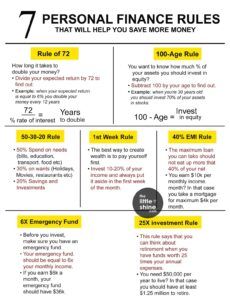For Master Your Money: Smart Personal Finance & Investment Strategies for Everyone
Introduction
All of us know money serves a purpose, but it doesn’t have to stressful. What if I told you that if done right, managing your finances could lead to decreased stress, long term protection of your assets, and wealth accumulation? Regardless of what step of the financial ladder you are on, there are timeless personal finance and investment strategies that we will talk about in this article.
1.Everyone is a Professional Budgeter:
You can’t invest for your Personal Finance & Investment until you have control of your cash flow. A budget isn’t restrictive—it’s empowering. Here’s how to get started:
TRACK YOUR SPENDING:
You can’t change what you don’t know, so have a hard look at your money by using apps like Mint or YNAB and actually figure out where it’s all going.
50/30/20 Rule:
Split your budget in the following way, 50 percent on your needs, 30 percent on your wants, and 20 percent to saving or debt repayment. Budgeting goes a long way, but save more by automating it: Setting up automatic transfers to high-yield saving accounts helps in the long term, even small amounts make a difference.
2. Kill Debt Before It Kills You (Personal Finance & Investment)
Personal Finance & Investment) High interest debt (such as credit cards) can crush your Personal Finance & Investment. Step 1: Prioritize: The Debt Snowball Method: Pay smallest debts first for quick victories.Method #2: Debt Avalanche Pay off your debts in order of interest accrued, starting with the highest, to save the most money over the coming decades. Refinancing: Consolidating loans or requesting lower rates where possible.Your best friend is time The sooner you begin for your Personal Finance & Investment the more compounding power will act for you.
Here’s how to begin:
- Start with Retirement: Max out employer-matched 401(k) contributions—it’s free money.
Shift to managing your risk: Investing in low-cost ETFs or Index S&P 500 funds helps with risk management and is a great way to diversify. Don’t Try to Time the Market: Stay away from speculative trading, long term investing and consistency pays off.
4.Create an Emergency Fund (Because Life Gets in the Way)
Aim for 3–6 months’ worth of expenses in a liquid account.
This shield protects against debt when budgetary surprises strike (medical bills, car repairs, job loss).
5.Keep Learning–It Pays to be Finacially Literate(Personal Finance & Investment)
- Read books like The Simple Path to Wealth (JL Collins) or Rich Dad Poor Dad (Robert Kiyosaki) to gain information related to Personal Finance & Investment.
-
Your can go to legitimate finance blogs, podcasts or YouTube channels.
-
If you’re in need of customized guidance, you might consider hiring a fee-only financial adviser.
- for more information click(FINANCIAL LITERACY)
In today’s economy, when grocery and gas prices are soaring, for many people the equivalent of driving in the dark is ignoring their finances altogether. Based on the data by the Federal Reserve, the average american household is in over $100000 of debt.
But: Consider Personal Finance & Investment your own personal superweapon. It frees you — freedom to travel, to start a business or to retire on your own terms. And investments? In this case, you can think of them as the rocket fuel that will propel you forward.
Step one: Build a rock solid budget, something akin to a financial GPS
It’s just as important to get your finances in order before even thinking about investing in stocks or bonds. It is not about deprivation; rather, it is about having a clear direction.
- Track Your Income and Expenses: Start by listing all your income sources (salary, side gigs, etc.) and categorizing expenses (essentials like rent and food vs. wants like dining out).That’s easy to do thanks to tools like Mint or YNAB (You Need A Budget).
-
Modify as necessary- like if you live in an expensive place, 60/20/20 is totally reasonable More info on 50/30/20 rule here:(50/30/20 RULE)
For further information regarding 50/30/20 rule click(50/30/20 RULE)
-
Cut the Leaks: Identify “vampire expenses” like unused subscriptions or impulse buys. I had one client come into my office saving $200 per month just by getting rid of streaming services they had forgotten to cancel!
Pro Tip: You should review your budget on a monthly basis. Your life changes — job promotions, surprise bills — and so should your plan. This one habit alone can potentially add another 10-20% to your savings rate over time.
Step 2: Become A Master Of Saving (Because Emergencies Need No Invitation)
Savings aren’t sexy, but they are your safety net.Try to save up to 3 to 6 months living expenses in a high yield savings account that automates your out of sight out of mind approach, where transfers to savings occur on payday, effectively setting it and forgetting it.
-
High-Interest Options: Look into money market accounts or CDs for better returns without much risk.
Saving isn’t just about setting money aside, it also increases the possibilities you can go after.
Step 3: Take the plunge into investments and let your money grow passively
Concerns over investing may make it seem like it is a difficult challenge to take on; however, it does not have to be that way, and with adopting proper measures, it can be a lot more straightforward. Blending different strategies is simpler to achieve if you decide to make a start and be persistent, showing that this approach can be effective.
-
Understand the Basics: Investments are assets that can appreciate over time. Common types include:
- Stocks: Ownership in companies. High potential returns, but volatile.Think Apple or Tesla.
. - Bonds: Loans to governments or corporations. Safer, with steady interest.
- Baskets of stocks or bonds can be broken down into Mutual Funds and ETFs: mutual funds or ETFs, yes. Vanguard mutual funds are suitable for novices and offer affordable options; for instance, their S&P 500 ETF.
- Real Estate: Via REITs (Real Estate Investment Trusts) if you don’t want to be a landlord.
- Stocks: Ownership in companies. High potential returns, but volatile.Think Apple or Tesla.
-
The Power of Compound Interest: It was aptly called the “eighth wonder of the world” by Einstein.
Put in just $200 a month for 30 years at 7% (the stock market’s historic average return), and you might have $200,000 — the majority from growth, not principal!
-
Risk Management: Don’t put all your eggs in one basket. Spread yourself out in terms of asset class, industry and geography. And as always, remember the golden rule: Never invest anything you can’t afford to lose.

Real Talk: The stock market isn’t a place to get rich quick. It’s a marathon. A lot of people sold at the lows during the crash of 2008.
Common Mistakes to Avoid (Things To Learn from Real-Life Terrors)
We have all heard horror stories — friends that followed “hot tips” and lost big, or families buried in credit card debt. Here’s how to sidestep them:
-
Emotional Investing: Don’t buy high on hype or sell low in fear.
-
Costs: Pay no attention to the overinflated fee structure. Actively managed funds with the higher fees will diminish value. In funds like these, rather pay no attention to fees at all; choose low-cost index funds after the fees.
-
Neglecting Taxes: Use tax-advantaged accounts like 401(k)s or IRAs to minimize your bill.
-
Lifestyle Inflation: As income rises, so do expenses. Fight it by saving raises automatically.
If you’re new to all of this, talk with a fiduciary financial planner who has a legal obligation to put your interests ahead of sales targets.
For information related to AI and Machine Learning applications click (AI and Machine Learning Applications)
For information related to Green Tech & Sustainability click (Green Tech & Sustainability)